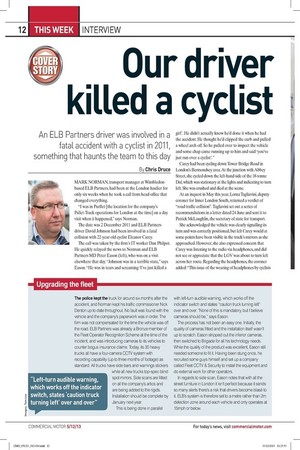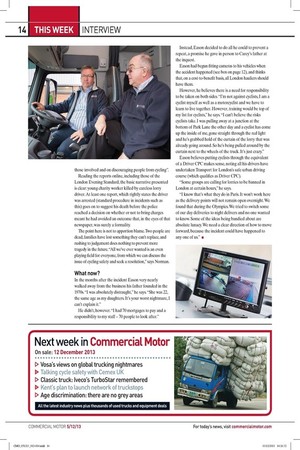Our driver killed a cyclist
Page 8

Page 9

Page 10

If you've noticed an error in this article please click here to report it so we can fix it.
An ELB Partners driver was involved in a fatal accident with a cyclist in 2011, something that haunts the team to this day By Chris Druce
MARK NORMAN, transport manager at Wimbledonbased ELB Partners, had been at the London haulier for only six weeks when he took a call from head office that changed everything.
"I was in Purflet [the location for the company's Pallet-Track operations for London at the time] on a day visit when it happened," says Norman.
The date was 2 December 2011 and ELB Partners driver David Johnson had been involved in a fatal collision with 22-year-old cyclist Eleanor Carey. The call was taken by the firm's IT worker Dan Philpot. He quickly relayed the news to Norman and ELB Partners MD Peter Eason (left), who was on a visit elsewhere that day. "Johnson was in a terrible state," says Eason. "He was in tears and screaming 'I've just killed a
girl'. He didn't actually know he'd done it when he had the accident. He thought he'd clipped the curb and pulled a wheel arch off. So he pulled over to inspect the vehicle and some chap came running up to him and said 'you've just run over a cyclist'.
Carey had been cycling down Tower Bridge Road in London's Bermondsey area. At the junction with Abbey Street, she cycled down the left-hand side of the 18-tonne Daf, which was stationary at the lights and indicating to turn left. She was crushed and died at the scene.
At an inquest in May this year, Lorna Tagliavini, deputy coroner for Inner London South, returned a verdict of "road traffic collision': Tagliavini set out a series of recommendations in a letter dated 24 June and sent it to Patrick McLoughlin, the secretary of state for transport. She acknowledged the vehicle was clearly signalling its turn and was correctly positioned, but felt Carey would at some points have been visible in the truck's mirrors as she approached. However, she also expressed concern that Carey was listening to the radio via headphones, and did not see or appreciate that the LGV was about to turn left across her route. Regarding the headphones, the coroner added: "This issue of the wearing of headphones by cyclists
on public roads also merits serious consideration in order to prevent further deaths."
The coroner expressed concern about the junction itself — a tight, acute-angle turn — and noted that the driver's need to position the truck slightly to the right to make the turn could have led to confusion. Vehicles can no longer make a left turn at the junction, which now features roadside safety mirrors. "I found no other contributory factors to Miss Carey's death," Tagliavini wrote. More to come
Carey was not the only victim of the collision. "After the incident, Johnson never came back to work," says Norman.
Johnson was so badly affected that Eason paid for 12 weeks of psychological counselling sessions for him after discovering that the NHS offered no help.
The company tried to bring him back into the business at the end of February 2012, having paid his salary throughout, but he couldn't face getting back in a truck. In April 2012 the previously healthy Johnson was diagnosed with bowel cancer. He died, aged 36, in September of that year. "Clearly the stress he was going through played a massive part in this," says Norman. Media reporting
Norman initiated a communication lockdown at the business in the aftermath of the incident, but speculation exploded across social media about the causes of the incident. "You can't stop it, but you just don't need people painting an even blacker image of haulage than already exists," says Eason.
He is concerned about biased reporting on collisions such as this one, and believes it to be part of a pro-cyclist bandwagon. This September he wrote to London Mayor Boris Johnson stating "enough is enough".
"The media were relentless. ELB Partners were written about in newspapers and on social websites. These reports were totally misleading, and this is often the trend," Eason wrote in his letter to Johnson. The mayor responded on the 21 October stating that he shared concerns around the "damaging nature of media coverage both in terms of the impact this can have on
those involved and on discouraging people from cycling".
Reading the reports online, including those of the London Evening Standard, the basic narrative presented is clear: young charity worker killed by careless lorry driver. At least one report, which rightly states the driver was arrested (standard procedure in incidents such as this) goes on to suggest his death before the police reached a decision on whether or not to bring charges meant he had avoided an outcome that, in the eyes of that newspaper, was surely a formality.
The point here is not to apportion blame. Two people are dead, families have lost something they can't replace, and rushing to judgement does nothing to prevent more tragedy in the future. "All we've ever wanted is an even playing field for everyone, from which we can discuss the issue of cycling safety and seek a resolution," says Norman.
What now?
In the months after the incident Eason very nearly walked away from the business his father founded in the 1970s. "I was absolutely distraught," he says. "She was 22, the same age as my daughters. It's your worst nightmare, I can't explain it."
He didn't, however. "I had 70 mortgages to pay and a responsibility to my staff —70 people to look after."
Instead, Eason decided to do all he could to prevent a repeat, a promise he gave in person to Carey's father at the inquest.
Eason had begun fitting cameras to his vehicles when the accident happened (see box on page 12), and thinks that, on a cost-to-benefit basis, all London hauliers should have them.
However, he believes there is a need for responsibility to be taken on both sides. "I'm not against cyclists, I am a cyclist myself as well as a motorcyclist and we have to learn to live together. However, training would be top of my list for cyclists," he says. "I can't believe the risks cyclists take. I was pulling away at a junction at the bottom of Park Lane the other day and a cyclist has come up the inside of me, gone straight through the red light and he's grabbed hold of the curtain of the lorry that was already going around. So he's being pulled around by the curtain next to the wheels of the truck. It's just crazy."
Eason believes putting cyclists through the equivalent of a Driver CPC makes sense, noting all his drivers have undertaken Transport for London's safe urban driving course (which qualifies as Driver CPC).
"Some groups are calling for lorries to be banned in London at certain hours," he says. "I know that's what they do in Paris. It won't work here as the delivery points will not remain open overnight. We found that during the Olympics. We tried to switch some of our day deliveries to night delivers and no one wanted to know. Some of the ideas being bandied about are absolute lunacy. We need a clear direction of how to move forward, because the incident could have happened to any one of us." •




































